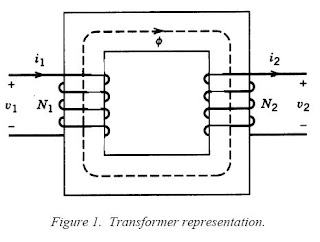ac voltage of is applied to a coil then it will produce a magnetic
field where the flux will alternate at the same frequency as the
voltage. Conversely if a coil is placed in an alternating magnetic
field then a voltage will be induced in the coil that will alternate at
the same frequency as the magnetic field. This is Faraday’s law
of electromagnetic induction, which can be expressed as:

If we now consider two coils that are closely coupled and we
apply a sinusoidal voltage to one of the coils where the voltage
is defined as:

The magnetic field produced by the first coil will induce a voltage
in the second coil. This is transformer action. To ensure that the
coils are closely coupled the coils should be wound on an iron
core, which will provide a path for the mutual flux linking the coils
(Q: Why will this be better than air?), to further improve the
coupling the second coil should be wound on top of the first coil.
For now the coupling between the coils will be assumed to be
ideal.
Apply Lenz’s law to the coils gives:
Apply Lenz’s law to the coils gives:

The current that produces the mutual flux will be a sine wave
that lags the voltage by 900, the flux will be in phase with the
current. In the case of the ideal transformer the reluctance of
the core will be zero (μr = ∞) and the current required to
produce the mutual flux will be zero.
With reference to figure 1and by applying Faraday’s and
With reference to figure 1and by applying Faraday’s and

